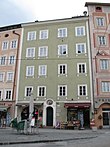Kajetanerplatz and Schanzlgasse
The Kajetanerplatz is the square in the old town of Salzburg , which is in front of the Kajetanerkirche of the same name . To the east, this square gradually becomes Schanzlgasse . Various gardens existed here until the 16th century. The area around the Chiemseehof was used as a hospital built by Archbishop Konrad , which soon included the Lorenz Church, which was inaugurated by Archbishop Eberhard in 1150 . The old people's home for the servants of St. Peter's Monastery was also located here. Wolf Dietrich wanted to build a new seminary here and therefore bought the church, hospital and garden. The church was rebuilt and now consecrated to Saint Anne, whose brotherhood it later served. Paris Lodron then redesigned the square in the course of expanding the fortifications.
About the names
The name Kajetanerplatz is reminiscent of the local Kajetan Church of St. Maximilian and its monastery (Kajetanerplatz 1) , which has been a hospital and convent of the Brothers of Mercy since 1923. The latest hospital building took place on the local "Kajetaner Bastion", part of the Lodron defense system. The church and monastery were built by Prince Archbishop Max Gandolf von Kuenburg as a monastery and monastery church for the Theatines, and this religious order existed here until 1809. After that it was a military hospital for a long time and a hospital since 1923. The founder of the Theatin order was Saint Kajetan von Thiene .
The adjacent Schanzlgasse is reminiscent of the once mighty Nonntaler Bastione, which Prince Archbishop Paris Lodron had built here in 1622–1624 to protect the city. This sprawling two-part bastion was called Nonntaler Schanze, but was popularly known as "Schanzl". Most of the bastions were demolished with the construction of the new judicial building there (1908). Parts of this old fortification have only been preserved below the Nonntal monastery. Schanzlgasse used to be called Stockhausgasse after the Stockhaus there.
Elephant house
(Kajetanerplatz 3)
This house was probably built in the early 16th century. Sometime after 1500 it belonged to the gunsmith Benedikt Reicher . On the house is, with the year 1679 and the abbreviation IHS, the following slogan: "Ask God Umb Grace at every hour, Dan without His help Geth everything to ground". The house has an upper exit to the Nonnbergstiege and further to the Nonnberg monastery. One floor of the house was once owned by the organ and piano maker Johann Evangelist Schmidt . For reasons no longer known today, the house has been called, at least since 1589, the "Elephant House".
Ritterhaus or Rötherhaus (actually Gutratherhaus)
(Kajetanerplatz 4)
Mentioned for the first time in 1380, the current structure dates from the beginning of the 16th century. Adam Franz Gutrather and his wife bought this building in 1691. The house is named after the gender known at the time.
Wage coach house, today Gasthaus zur Glocke
(Schanzlgasse 2)
Between 1671 and 1675 the property was built with a house, a stable and a barn. The current facade dates from around 1800. There are four renewed segment arch openings on the ground floor of the house. At the place of this house a steep staircase partly made of wood and partly of stone led up to the monastery of Nonnberg before 1657 , which was only demolished in 1835. Only the lowest part of the stairs in the house itself has been preserved.
For many decades until the 2010s, the Gasthaus zur Glocke was located here , as indicated by a wrought-iron wall arm with a bell. The restaurant is currently run as an Italian trattoria .
Glockengießerhaus, (stick) stick house, today Gasthof Hinterbrühl
(Schanzlgasse 12)
The essentially late Gothic house (built in 1380 as part of the old city wall) is known as the Glockengießerhaus in 1650, which was owned by the City of Salzburg and has been in the 4th generation of the Wagner family since 1959. After 1800 the name Stockhaus appears. As with many other old houses, frequent renovations result in a detailed and irregular interior.
Schanzlwirt, today a state kindergarten
(Schanzlgasse 14)
This house was probably built after 1700 and was run for a long time after around 1810 as the “Gasthof zum (White) Lamm”. From this house a direct staircase also led up to the Nonnberg monastery. A commemorative plaque on the house refers to the stay of Alexander von Humboldt in this house: "Alexander von Humboldt lived and worked in this house from October 26th, 1797 to April 24th, 1798 before his world tour"
Almost all of the house stands on the old Äußere Nonntaler Tor (Erentrudistor), which was built between 1465 and 1480 and was part of the 2nd city fortifications. The gate was only rediscovered in 1975 during renovation work on the train in 1975. The old archway consists almost entirely of large ashlar stones. It is 14 m long and has a round arch vault. The loopholes are closed because they are currently below the level of Schanzlgasse. In the Schanzlgasse you can see the heavily poured out small outer parts of the gate system.
swell
- Bernd Euler, Ronald Gobiet, Horst Huber: Dehio Salzburg - City and Country. Verlag Anton Schroll & Co, Vienna 1986, ISBN 3-7031-0599-2
- FW Zillner; History of the City of Salzburg, - special volumes of the Society for Salzburg Regional Studies, Salzburg 1885
Coordinates: 47 ° 47 ′ 48 ″ N , 13 ° 3 ′ 6 ″ E





